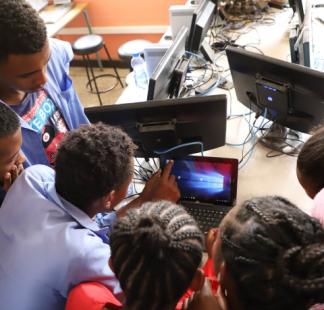Government Technology Agency office in Thimphu, Bhutan
Thimphu
Bhutan
- Akanksha Sharma
Introductory
Event Organizer(s)


Description
Enhance the capacity and awareness among government officials and key stakeholders on artificial intelligence technologies for increasing the efficiency of telecommunications/ICTs and the development and implementation of related ICT standards within the ITU's mandate and core competencies especially those described in the PP Resolution 214 (Bucharest, 2022), Artificial intelligence (AI) technologies and telecommunications/information and communications technologies.
With the generous support of the Ministry of Internal Affairs & Communications of Japan, the workshop will focus on core concepts and fundamentals of AI for Bhutanese civil servants to be equipped and sensitized towards its governance, ethical aspects and possible risks. The course will include several global best practices and examples of AI applications from around the world for Bhutan to evaluate how AI can address its existing national challenges.
Policy-level stakeholders (mid to senior) responsible for policy making in the field of telecommunications/ICTs (i.e., government officials, bureaucrats, regulators and digital government project managers).
Technical stakeholders, responsible for developing and implementing AI technologies and policies for telecom and ICT in Bhutan.
Qualifications or experience needed to participate in this training course:
- Bachelor’s degree or practical experience in the fields of telecommunication regulation, policy making, governance, policy implementation and AI technologies.
Number of available places for the cohort: Maximum 40 per batch
Upon completion of this course, participants will be able to:
- Develop a basic understanding of AI principles. Evaluate and assess Bhutan-relevant AI use cases as well as initiatives.
- Incorporate artificial intelligence (AI) technologies within their national ICT strategies.
- Trained and sensitized group of civil servants ready to support AI initiatives.
During the F2F workshop, participants will be introduced to core concepts and fundamentals of AI using a classroom/tutoring format, leading to discussions in the form of group exercises, e.g., writing a problem statement, problem framing and ideation, solution development followed by group presentations. The participants will be guided through all group exercises by the tutors.
Participation in the F2F part of the workshop as well as an overall passing grade of 70% is required to receive a Certificate of Completion. Interactive quizzes will be throughout the sessions.
Day 1
Opening Session for First Training
AI Fundamentals
Learning outcomes:
- Importance of AI for Bhutan’s digital transformation, Relevance of AI in governance, public service delivery, and national development goals
- Definition, history, and evolution of AI
- Types of AI: Narrow AI, General AI, and Super AI
- AI vs. traditional programming
Core Concepts of AI
Learning outcomes:
- Data, algorithms, and computing power
- Introduction to key technologies: Machine Learning, Deep Learning, Natural Language Processing, and Computer Vision
- Real-life examples from government and public services including possible risks
AI in Practice and Public Sector Use Cases
Learning outcomes:
- AI applications in improving public services, examples from India and other countries.
- Responsible AI and Bhutan’s values (Gross National Happiness, equity, sustainability). Potential replicability of AI solutions in Bhutan’s context.
- Role of international frameworks & standards in developing AI
Group Exercise 1
Learning outcomes:
- Ask participants to identify 5 areas where AI can help solve current challenges in Bhutan
- Select one of the 5 and turn it into a “problem statement”
Day 2
Group Exercise 2: Problem Framing and Ideation
Learning outcomes:
- Identify the problem and define the use case.
- What data is needed? Who are the stakeholders?
- What type of AI solution could help?
Group Exercise 3: Solution Development
Learning outcomes:
- Sketch out the AI solution.
- Consider risks and feasibility from a national perspective.
- Define key success indicators.
Group Presentations
Learning outcomes:
- Each group presents their solution (10-15 mins. each).
- Feedback from other groups and trainers.
- Possible voting or commendations (e.g., “Most Scalable,” “Most Innovative,” etc.)
Day 3
Deployment of AI solutions in Bhutan
Learning outcomes:
- Define what’s needed to successfully deploy the AI solutions created by groups
- Discuss how civil servants can contribute to Bhutan’s AI readiness
- Key considerations for implementation: capacity, data, partnerships
- Identifying AI champions within departments
- Introduce a community of practice or follow-up initiative
Define Next Steps
Learning outcomes:
- How can ITU assist Bhutan to accelerate its digital transformation leveraging AI?
- ITU resources: Standards, ITU Academy, Needs assessment etc











